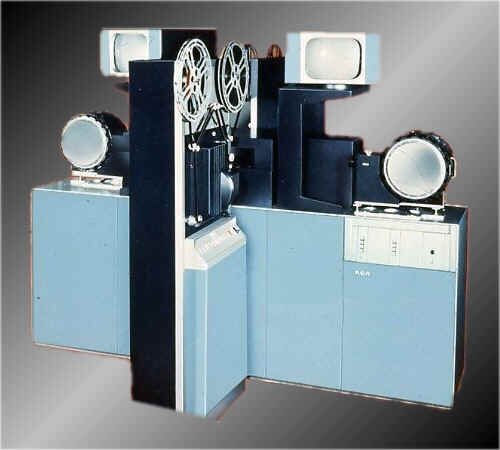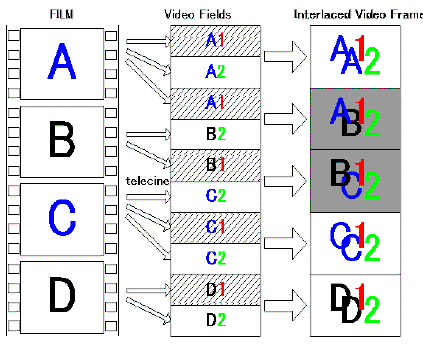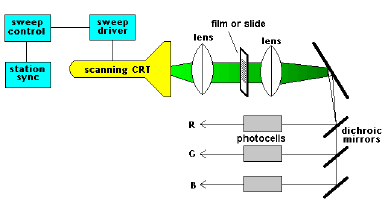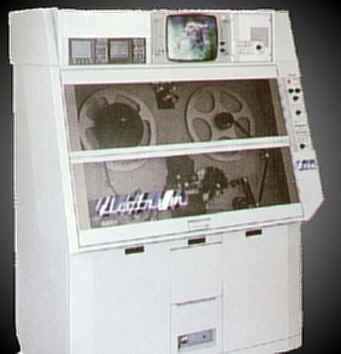|














 





|



"This film needs a certain something. Possibly burial."
-- David Lardner, reviewing Panama Hattie, 1942
Film, as a finished edited and printed product, used to be one of the major program sources in television, but now it's pretty much restricted to movies and occasionally documentaries. Much program material is still shot on film, but it is immediately transferred to tape for editing and distribution.

Typical telecine system (courtesy Barry Mishkind, www.oldradio.com)
Film is classified according to its width (8mm, Super 8, 16mm, 35mm, 70mm and more) and its sound track type (silent, optical sound, magnetic sound). Television film projectors can accommodate either optical or magnetic sound.
Telecine
Also known as the film chain or film island, telecines consist of at least one film projector, a slide projector, a multiplexer (selector for film or slides) and a telecine camera.
|
Projector
|
The television film projector is especially designed so (generally 16mm) film, running at 24 frames per second, synchronizes with the 30 frames per second rate of television. This is accomplished by scanning the first frame of film twice (two fields), the next frame three times (three fields), the third twice, and so on. This is called "three two pulldown".
Other important differences between regular and telecine film projectors include:
 |
the ability to come up to full speed within a second or two, thus eliminating the need for a pre-roll |
 |
easy, open-to-view threading mechanisms |
 |
remote start and stop controls |
 |
the ability to show a single frame for some time, for cueing purposes, without burning through the film |
 |
projection and optical sound lamps that automatically exchange themselves with a spare, should they fail during projection |
|

Film to video conversion, featuring 3-2 pulldow
|
Slide Projectors
Slide projectors have two vertically or horizontally arranged drums, usually holding about 18 slides each. Most are designed for forward and reverse action; some have a random selection, programmable system. While slides are easier to use than studio cards, the fixed telecine camera cannot move over the frame. Also, vertically formatted 35mm slides cannot be used in a telecine slide projector - the top and bottom of the frame will be cut off.
Multiplexer / Telecine Camera
The multiplexer is the series of mirrors or prisms that direct the images from the projectors into the telecine camera.
The telecine camera is similar to a regular television camera. Most have some form of electronic or electro-mechanical means of automatic brightness control. Some also have internal or external automatic colour correction systems.
Flying Spot Scanners
|

Principles of flying spot scanner telecine transfer

Flying spot scanner (courtesy Cintel)
|
In the 1970s, another type of film transfer system was developed, called the flying spot scanner. It involves a CRT with a bright phosphor and a standard scanning pattern, focused on each frame of film. As the tiny spot of light passes different points on the film, it picks up the colour information for that particular frame. It is then passed through a series of dichroic filters to separate it into its red, green and blue components. Three photocells detect the amount of RGB information at any particular spot. These three outputs are made available to colour correction devices and are then colour encoded in the usual fashion and presented to monitors, VTRs and the like.
The advantage of this system is that the detail and resolution of the scanned image are usually far superior to standard telecine transfer techniques. Also, because of the pattern of the scanning, the film can be transferred through the system in a more gentle fashion than the "pull down claw" process used in standard telecine projectors.
Another, less obvious advantage to flying spot scanning systems is that it is a simple matter to zoom in on film or a slide. All that is involved is that the scanning takes place over a smaller area of each frame. This allows motion picture films to be scanned in any of several different formats. The more common ones are "letterbox" (where the full film is shown on the television screen, but there are black bands at the top and bottom of the 4:3 television monitor), and "pan and scan" (where the wider aspect film is panned by a 4:3 TV ratio area to show the most important action of a scene.) Because the internal image at any instant is only a tiny dot, as seen by the photocell, this means that more emphasis is being applied to fewer pixel elements. With the high information density of film and the relatively high resolution of the flying spot scanner, an image section can be magnified several times without graininess or loss of picture detail.
|
Converting Video to Film
Television shows (and especially, commercials and music videos) are often shot on film, as it imparts a certain look and feel to the project. The contrast ratio is much higher in film than in videotape, and there is a subtle grain that permeates the footage. However, film can be a rather expensive format on which to shoot. The original stock can't be reused (as can videotape), and there are costs involved with developing of the negative, work printing, editing, negative cutting, optical effects, release prints, and so forth.
There are some methods available to convert the sharp "look" of videotape to the softer appearance of film. Finished video footage can be converted, frame by frame, through software products such as Adobe AftereffectsTM, using a plug-in that adds grain, softness, even scratches to your production. There is also an Academy Award winning, patented "black box" that converts video to film in real time called FilmlookTM. The results can be quite stunning, but the process is expensive - about $100 per minute of footage.
Things to Think About
Telecines are an older way of transferring slides and motion picture film to video. They have various component parts which combine together to form a telecine chain.
Flying spot scanners are a more recent transfer system that have definite advantages over the old telecine system.
There are processes that convert originally shot videotape to a film look and texture.






